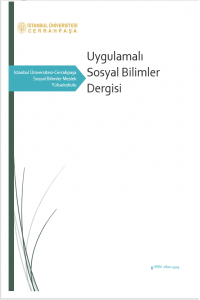TESTING INTERNATİONAL PARITY HYPOTHESIS IN A MULTIVARIATE IDENTIFIED CO-INTEGRATING SYSTEM: THE TURKISH EVIDENCE
Bu çalışmada, çok değişkenli bîr eş-bütünleşirn modeli Türkiye ekonomisi üzerine satın alma gücü parkesi ve korunmamış faiz paritesi kuramlarının eşanh incelenmesi amacıyla oluşturulmaktadır. Tanımlanmış eş-bütünieşik vektörlerden elde edilen tahmin sonuçlanÖnsel modcüeme beklentilerini desteklemekte ve her iki pari tenin birbirleri içerisine bülünleştiril meleri durumunda varlığına yönelik bulgular üretmektedir. Bununla birlikte, birbirlerinden ayrı olarak formülleştirilmeleri durumunda iki uluslar arası döviz kuru belirlenme paritesi doğrultusunda bulgu elde edilememektedir. Çalışmadan türetilen bir politika çıkarsaması, piyasa mekanizması parasal döviz kurunun uzun dönemli gelişim yolunu yakından etkiler bir şekilde gözlendiği için döviz kuru temelli istikrar programlarının iktisadi birimler tarafından İhtiyatlı bir şekilde değerlendirilmesi gerekliliği olarak özetlenebilir. Anahtar kelimeler: Satın Alma Gücü Paritesi; Korunmamış Faiz Paritesi; Türkiye Ekonomisi   ABSTRACThi this paper, a multivariate co-integrating model is contracted upon the Turkish economy to examine the validity of the purchasing power parity and the uncovered interest parity theories simultaneously. Estimation results obtained from identified co-integrating vectors supporta priori modelling expectations and yield evidence to the existence of both parities when integrated within each other. However, no evidence is obtained İn favor of the two international exchange rate determination parity hypotheses when formulated in isolation. A policy inference derived from the paper can be summarized such that since the market mechanisms seem to closely affect the long-run course of the nominal exchange rate, exchange rate based stabilization programs should be appreciated by economic agents in a cautious way. Key words:Purchasing Power Parity; Uncovered Interest Parity: Turkish Economy.
Anahtar Kelimeler:
Satın Alma Gücü Paritesi, Korunmamış Faiz Paritesi, Türkiye Ekonomisi
___
- BANERJEE, A., R.L. LUMSDAINE, and J.H. STOCK; (1992), "Recursive and Sequential Tests of the Unit Root and Trend Break Hypothesis," Journal of Business and Economic Statistics, 10, pp. 271-87.
- CAPORALE, M.G., S. KALYVITIS, and N. PITTIS; (2001), "Testing for PPP and UIP in an F1ML Framework: Some Evidence for Germany and Japan", Journal of Policy Modeling, 23, pp. 637-50.
- DORNBUSCH, R; (1976), "Expectations and Exchange Rate Dynamics", Journal of Political Economy, 84(6), pp. 1161-176.
- GOKCAN, A. and E. OZMEN; (2002), "Do PPP and UIP Need Each Other in a Financially Open Economy? The Turkish Evidence", ERG Working Papers in Economics, No. 01/01.
- GONZALO, J.; (1994), "Five Alternative Methods of Estimating Long-run Equilibrium Relationships", Journal of Econometrics, 60, pp. 203-33.
- GRANGER, C.W.J, and P. NEWBOLD; (1974), "Spurious Regressions in Economics", Journal of Econometrics, 2(2), pp. 111-20.
- HARRIS, R.I.D.; (1995). Using Cointegration Analysis in Econometric Modelling, Prentice Hall.
- JOHANSEN, S.; (1988), "Statistical Analysis of Cointegration Vectors", Journal of Economic Dynamics and Control, 12, pp. 231-54.
- JOHANSEN, S.; (1992), "Determination of Cointegration Rank in the Presence of a Linear Trend", Oxford Bulletin of Economics and Statistics, 54(3), pp. 383-97.
- JOHANSEN, S.; (1995), Likelihood-based Inference in Co-integrated Vector Auto regressive Models, Oxford University Press, 1995.
- JOHANSEN, S. and K. JUSELIUS; (1990), "Maximum Likelihood Estimation and Inference on Cointegration-with Applications to the Demand for Money", Oxford Bulletin of Economics and Statistics, 52, pp. 169-210.
- JOHANSEN, S. and K. JUSELIUS ; (1992), "Testing Structural Hypotheses in a Multivariate Cointegration Analysis of the PPP and the UIP for UK", Journal of Econometrics, 53, pp. 211-44.
- JUSELIUS, K.; (1995), "Do Purchasing Power Parity and Uncovered Interest Rate Parity Hold in the
- Long Run? An Example of Likelihood Inference in a Multivariate Time-series Model", Journal of Econometrics, 69, pp. 211-40.
- MACDONALD, R.; (2000), "Concepts to Calculate Equilibrium Exchange Rates: An Overview", Economic Research Group of the Deutsche Bundesbank Discussion Paper, No. 3/00.
- PERRON, P.; (1989). "The Great Crash, the Oil Price Shock, and the Unit Root Hypothesis", Econometrica, 57, pp. 1361-1401.
- PERRON, P.; (1990). "Testing for a Unit Root in a Time Series with Changing Mean", Journal of Business and Economic Statistics, 8, pp. 153ı 62.
- ZIVOT, E. and D.W.K. ANDREWS; (1992), "Further Evidence of Great Crash, the Oil Price Shock and the Unit Root Hypothesis", Journal of Business and Economic Statistics, 10, pp. 251ı 70.
- Başlangıç: 2007
- Yayıncı: İstanbul Üniversitesi-Cerrahpaşa
Sayıdaki Diğer Makaleler
MOBİLYA SEKTÖRÜ KURULUŞ YERİ SEÇİMİNDE ANALATİK HİYERARŞİ PROSESİ (AHP) UYGULAMASI
TÜRKİYE'DE İKTİSADİ GÜVEN: ULUSLARARASI BİR KARŞILAŞTIRMA
BULANIK HEDEF PROGRAMLAMA ve SU HAVZASINDA BİR UYGULAMA
EKONOMETRİK MODELLERDE EKSİK GÖLGE DEĞİŞKENLERİN GENETİK ALGORİTMALAR İLE TESPİT EDİLMESİ
YÜKSEK ÖĞRETİMDE ALGILANAN KALİTE BOYUTLARI: BİLECİK METEB BÖLGESİ ÖRNEĞİ
Salim ŞENGEL, Mehpare TOKAY ARGAN, Metin ARGAN
GRAW VE EWMA ile RİSKE MARUZ DEĞER: ALTIN GETİRİSİ İÇİN BİR UYGULAMA
TÜRKİYE'DE CARİ İŞLEMLER AÇIKLARININ SÜRDÜRÜLEBİLİRLİĞİ
Turizm Eğitimi Alan Öğrencilerin Etik Algılamaları Üzerine Bir Araştırma
İTİBAR KAZANMAK: KURUMSAL YÖNETİM İÇİN PAYDAŞ YAKLAŞIMLARI GELİŞTİRMEK
